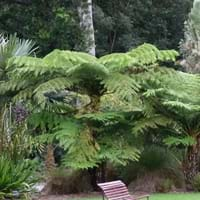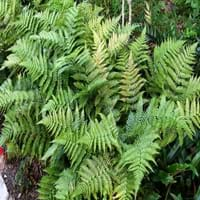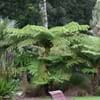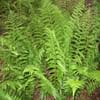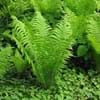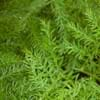Life Span
Perennial
Perennial
Origin
Australia
China, Japan
Types
Not Available
Dryopteris fili-mas, Dryopteris affinis, Dryopteris carthusiana
Habitat
Damp Places
Woodlands
USDA Hardiness Zone
10-15
5-9
Sunset Zone
H2, 8, 9, 14, 15, 16, 17, 19, 20, 21, 22, 23, 24
2a, 2b, 3a, 3b, 4, 5, 6, 7, 8, 9, 14, 15, 16, 17, 18, 19, 20, 21, 22, 23, 24
Habit
Arching/Fountain-shaped
Clump-Forming
Flower Color
Non Flowering Plant
Not Available
Flower Color Modifier
Bicolor
Bicolor
Fruit Color
Not Available
Not Available
Leaf Color in Spring
Light Green
Light Green, Yellow green, Pink, Copper
Leaf Color in Summer
Dark Green
Green
Leaf Color in Fall
Dark Green
Brown, Dark Red, Bronze
Leaf Color in Winter
Dark Green
Red, Brown
Leaf Shape
Fern like
Fern like
Plant Season
Spring, Summer, Fall, Winter
Spring, Summer, Fall
Sunlight
Partial shade
Partial shade
The pH of Soil
Acidic
Acidic, Neutral
Soil Drainage
Average
Average
Bloom Time
Not Available
Not Available
Tolerances
Not Available
Not Available
Where to Plant?
Ground
Container, Ground, Pot
How to Plant?
Spores
Divison, Spores
Plant Maintenance
Medium
Medium
Watering Requirements
Requires consistently moist soil
Average Water Needs, Do Not over Water, Requires regular watering
In Summer
Lots of watering
Lots of watering
In Spring
Moderate
Moderate
In Winter
Average Water
Average Water
Soil pH
Acidic
Acidic, Neutral
Soil Drainage Capacity
Average
Average
Sun Exposure
Full Shade, Partial shade
Partial shade
Pruning
Remove damaged leaves, Remove dead branches, Remove dead leaves
Remove damaged leaves, Remove dead branches, Remove dead leaves, Remove dead or diseased plant parts
Fertilizers
All-Purpose Liquid Fertilizer
All-Purpose Liquid Fertilizer, slow-release fertilizers, Water soluble fertilizers
Pests and Diseases
Squirrels
Red blotch
Plant Tolerance
Drought
Not Available
Flower Petal Number
Single
Single
Foliage Texture
Fine
Medium
Foliage Sheen
Matte
Glossy
Attracts
Ants
Birds, Butterflies
Allergy
Carcinogenic
Not Available
Aesthetic Uses
Not Available
Borders, Showy Purposes
Beauty Benefits
Not Available
Not Available
Edible Uses
Yes
Insignificant
Environmental Uses
Air purification
Air purification
Medicinal Uses
Astringent
Not Available
Part of Plant Used
Leaves, Stem
Not Available
Other Uses
Not Available
Showy Purposes
Used As Indoor Plant
No
No
Used As Outdoor Plant
Yes
Yes
Garden Design
Container, Feature Plant, Tropical
Container, Feature Plant, Groundcover, Mixed Border
Botanical Name
DICKSONIA antarctica
DRYOPTERIS erythrosora
Common Name
Australian tree fern, Tasmanian tree fern, hardy tree fern, soft tree fern, woolly tree fern
Autumn fern, Japanese wood fern, Copper shield fern
In Hindi
Tasmanian Tree Fern
Autumn Fern Tree
In German
Tasmanian Tree Fern
Herbst Fern Tree
In French
Dicksonia antarctica
Autumn Fern Tree
In Spanish
Balantium antarcticum
Otoño Fern Tree
In Greek
Tasmanian Tree Fern
Φθινόπωρο δέντρο φτέρη
In Portuguese
Dicksonia antarctica
Samambaia de árvore Autumn
In Polish
Diksonia antarktyczna
Jesień Drzewo paproci
In Latin
Tasmanian Tree Fern
Autumnus Fern tree
Phylum
Pteridophyta
Vascular plant
Class
Filicopsida
Leptosporangiate fern
Order
Polypodiales
Polypodiales
Family
Dicksoniaceae
Dryopteridaceae
Genus
Dicksonia
Dryopteris
Clade
Not Available
Not Available
Tribe
Not Available
Not Available
Subfamily
Not Available
Not Available
Number of Species
Not Available
Not Available
Properties of Tasmanian Tree Fern and Autumn Fern
Wondering what are the properties of Tasmanian Tree Fern and Autumn Fern? We provide you with everything About Tasmanian Tree Fern and Autumn Fern. Tasmanian Tree Fern doesn't have thorns and Autumn Fern doesn't have thorns. Also Tasmanian Tree Fern does not have fragrant flowers. Tasmanian Tree Fern has allergic reactions like Carcinogenic and Autumn Fern has allergic reactions like Carcinogenic. Compare all the properties and characteristics of these two plants. Find out which of these plant can be used as indoor plant. If you are interested to decorate your house and garden, find out aesthetic uses, compare them and select the plant which will beautify your surrounding. Along with beautification, try comparing medicinal and edible uses of Tasmanian Tree Fern and Autumn Fern and you can choose the plant having best and most benefits.
Season and Care of Tasmanian Tree Fern and Autumn Fern
Season and care of Tasmanian Tree Fern and Autumn Fern is important to know. While considering everything about Tasmanian Tree Fern and Autumn Fern Care, growing season is an essential factor. Tasmanian Tree Fern season is Spring, Summer, Fall and Winter and Autumn Fern season is Spring, Summer, Fall and Winter. The type of soil for Tasmanian Tree Fern is Loam and for Autumn Fern is Loam while the PH of soil for Tasmanian Tree Fern is Acidic and for Autumn Fern is Acidic, Neutral.
Tasmanian Tree Fern and Autumn Fern Physical Information
Tasmanian Tree Fern and Autumn Fern physical information is very important for comparison. Tasmanian Tree Fern height is 240.00 cm and width 120.00 cm whereas Autumn Fern height is 60.96 cm and width 60.96 cm. The color specification of Tasmanian Tree Fern and Autumn Fern are as follows:
Tasmanian Tree Fern flower color: Non Flowering Plant
Tasmanian Tree Fern leaf color: Light Green
Autumn Fern flower color: Not Available
- Autumn Fern leaf color: Light Green, Yellow green, Pink and Copper
Care of Tasmanian Tree Fern and Autumn Fern
Care of Tasmanian Tree Fern and Autumn Fern include pruning, fertilizers, watering etc. Tasmanian Tree Fern pruning is done Remove damaged leaves, Remove dead branches and Remove dead leaves and Autumn Fern pruning is done Remove damaged leaves, Remove dead branches, Remove dead leaves and Remove dead or diseased plant parts. In summer Tasmanian Tree Fern needs Lots of watering and in winter, it needs Average Water. Whereas, in summer Autumn Fern needs Lots of watering and in winter, it needs Average Water.
